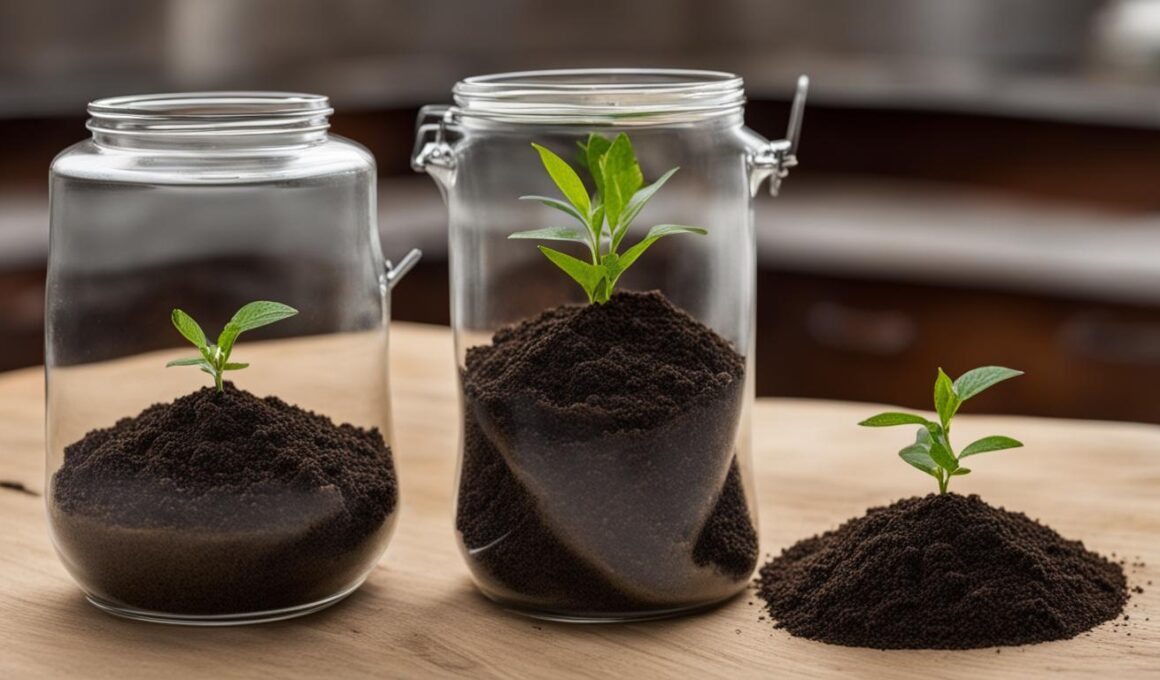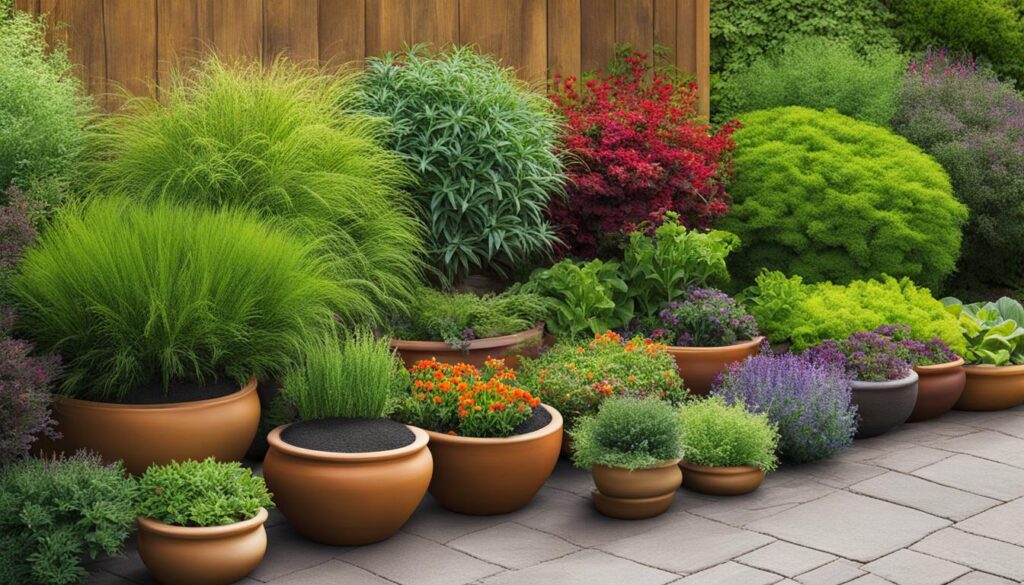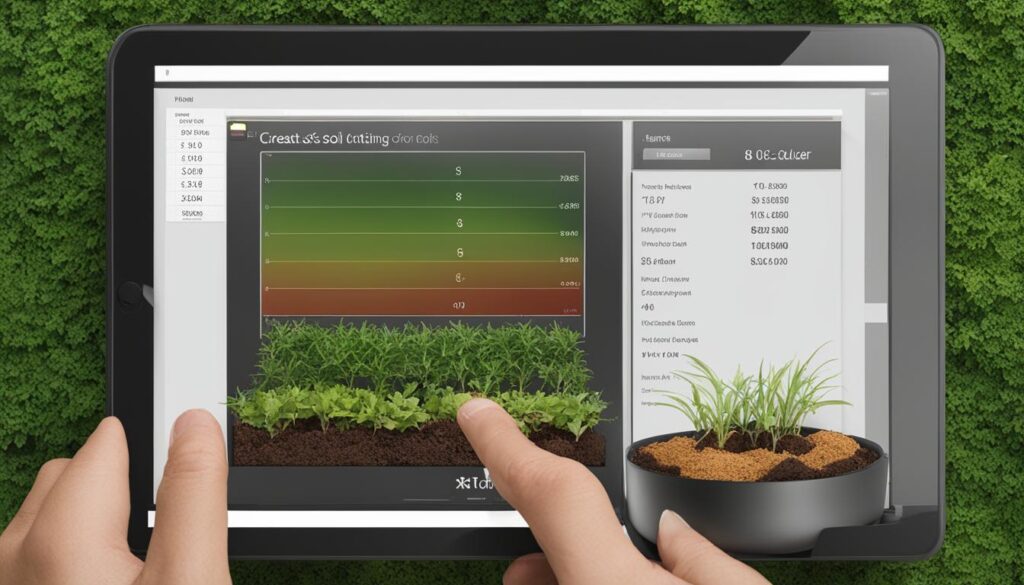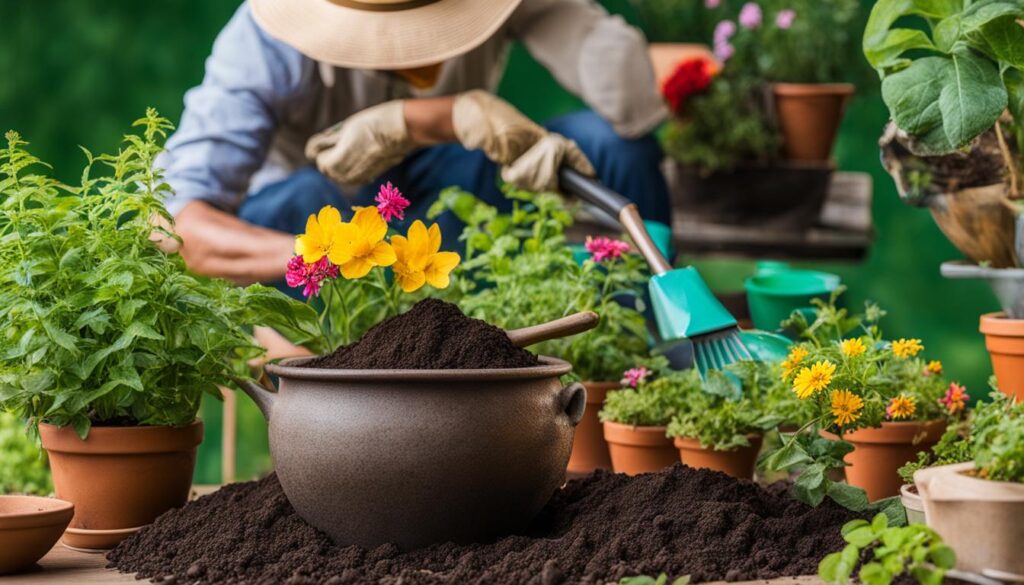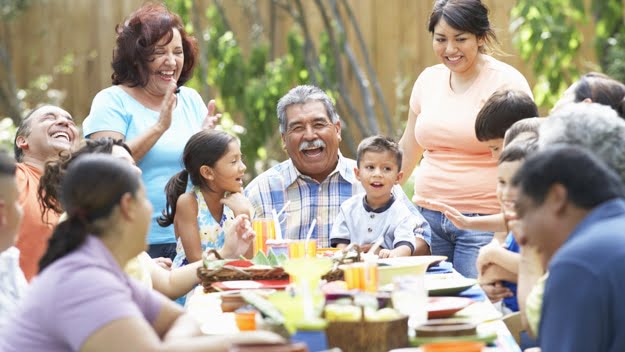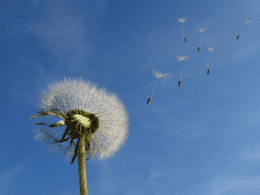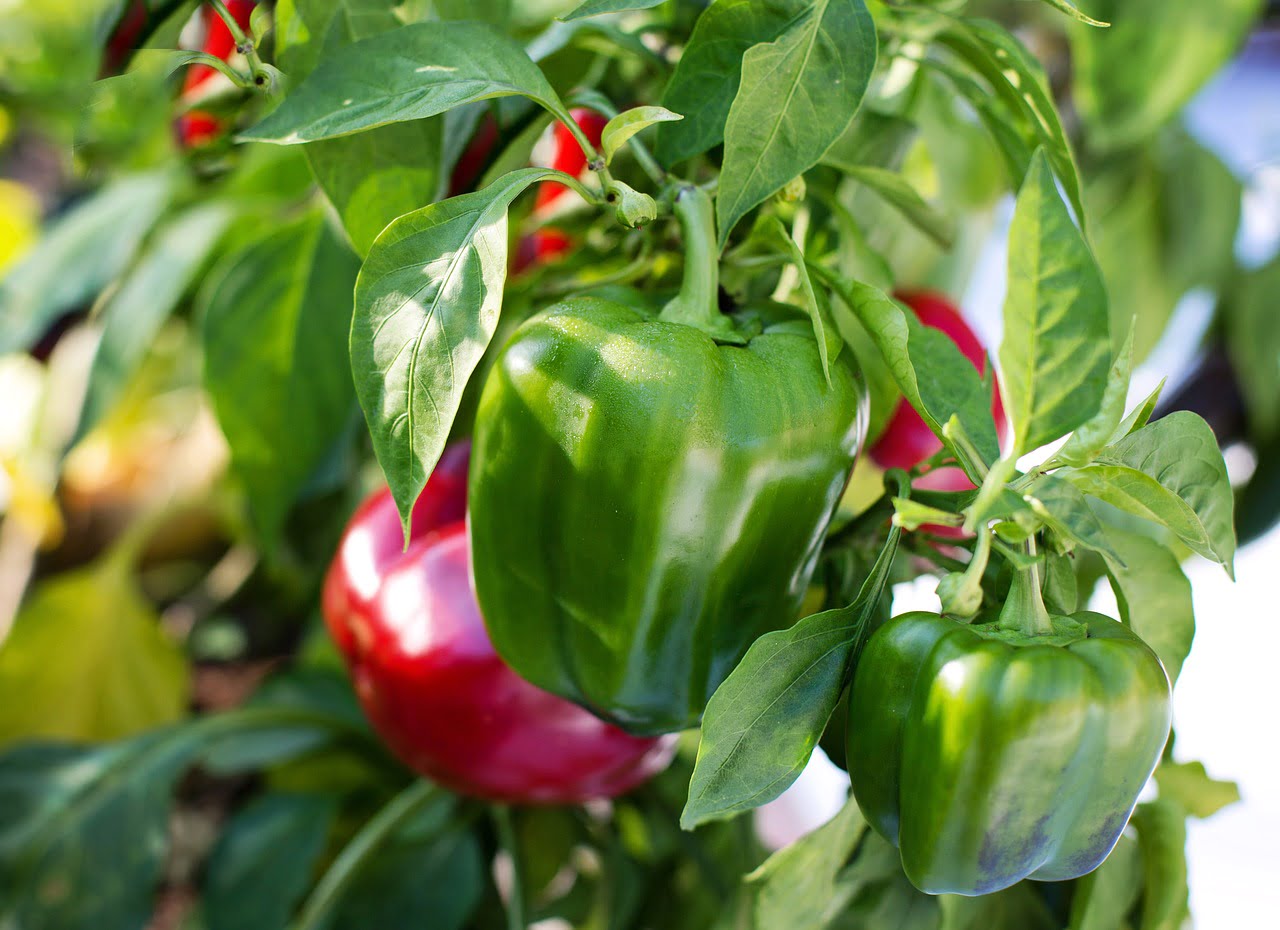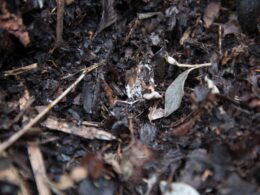When gardening in containers, it is important to provide your plants with the right amount of soil to ensure optimal growth. The volume of soil needed for an 8 inch pot can vary depending on the type of pot and the specific plant you are growing. By using a potting soil calculator and considering factors like pot shape and desired fill level, you can determine the approximate amount of soil required.
Key Takeaways:
- Determining the right amount of soil for an 8 inch pot is crucial for successful container gardening.
- Factors to consider when determining soil volume include pot shape and desired fill level.
- Using a potting soil calculator can help provide an accurate estimate of the soil required.
- Approximate soil volumes for different pot sizes can serve as a general guide.
- Estimating soil volume can be challenging, but considering soil compression and existing plants or roots can help.
Factors to Consider When Determining Soil Volume
Calculating the soil volume for an 8 inch pot requires considering several factors. Understanding these factors will help you determine the right amount of soil for your container gardening needs. Here are the key factors to consider:
- Pot Shape: Different pot shapes, such as standard clay pots, hanging baskets, or bowls, will require varying amounts of soil. The shape of your pot will affect the overall volume.
- Fill Level: The desired fill level of your pot also influences the amount of soil needed. Whether you want to fill the pot fully or partially will impact the soil volume calculation.
- Existing Plants or Roots: Take into account any existing plants or roots in the pot. These will displace some of the soil volume, so consider their presence when determining the overall soil volume.
By considering these factors, you can make a more accurate estimation of the soil volume required for your 8 inch pot. This will ensure that your plants have enough space and nutrients to thrive in their container environment.
Importance of Pot Shape and Fill Level
Pot shape and fill level are crucial factors to consider when determining the soil volume for an 8 inch pot. The shape of the pot will have a direct impact on the available space for soil, with different shapes having different capacities. Additionally, the desired fill level, whether you want to fill the pot fully or partially, will affect the soil volume calculation. It is important to take these factors into account to ensure your plants have adequate growing space and nutrient availability.
When calculating the soil volume for your 8 inch pot, keep in mind the pot shape, fill level, and any existing plants or roots. These considerations will help you determine the right amount of soil for your container gardening project, creating an optimal environment for your plants to thrive.
Using a Potting Soil Calculator
When it comes to determining the exact amount of soil needed for your 8 inch pot, using a potting soil calculator can be incredibly helpful. These online calculators take into account the dimensions of your pot, such as diameter and height, and provide you with an accurate estimate of the soil volume required. By simply inputting these measurements, you can save time and ensure you purchase the right amount of soil for your container gardening needs.
Using a potting soil calculator is easy. Start by finding a reliable calculator online that allows you to input the dimensions of your pot. Once you have the calculator open, enter the diameter and height of your 8 inch pot. The calculator will then calculate the corresponding soil volume in dry quarts or other units of measurement.
One of the advantages of using a potting soil calculator is that it takes the guesswork out of determining soil volume. Instead of relying on rough estimates or guesswork, the calculator provides you with precise measurements. This can help you avoid overfilling or underfilling your pot and ensure that your plants have enough space for their roots to grow and thrive.
By utilizing a potting soil calculator, you can confidently determine the amount of soil needed for your 8 inch pot. This tool is especially useful for beginners or those unfamiliar with container gardening, as it provides a convenient and accurate way to calculate soil volume. So before you start potting your plants, take a few minutes to use a potting soil calculator and ensure that you have the right amount of soil for successful container gardening.
Approximate Soil Volumes for Different Pot Sizes
When it comes to container gardening, knowing the approximate soil volumes for different pot sizes can be incredibly helpful. Having a general idea of the amount of soil needed for each pot size allows you to plan and prepare accordingly. Here is a table that provides approximate soil volumes for different pot sizes, including the popular 8 inch pots:
Table: Approximate Soil Volumes for Different Pot Sizes
| Pot Size (Inches) | Soil Volume (Dry Quarts) |
|---|---|
| 4 | 2 |
| 6 | 4 |
| 8 | 6 |
| 10 | 12 |
| 12 | 24 |
Please note that these measurements are approximate and can vary depending on factors like soil compression and existing plant material in the pot. However, they can serve as a useful guide when determining the soil volume for your container gardening needs.
By understanding the approximate soil volume required for different pot sizes, you can ensure that you have enough soil to provide your plants with the necessary nutrients and growing space. This knowledge is particularly valuable if you are planning to grow a variety of plants in different pots. Remember to consider factors like pot shape and fill level to get a more accurate estimate. With the right amount of soil, you can create a healthy and thriving container garden.
Tips for Estimating Soil Volume
Estimating the soil volume needed for an 8 inch pot can be a bit challenging, but with some helpful tips, you can make a more accurate estimation. One important factor to consider is soil compression. When moistening and pressing the soil into the pot, it tends to compress, taking up less space than when it is dry. To account for this, it is recommended to add an additional 15% to 20% of dry soil to the container.
Another consideration is any existing plants or roots in the pot. These will displace some of the soil, reducing the actual volume needed. Take note of the soil volume used in your own pots, as this can serve as a reference for future estimations. It’s always better to have a little extra soil available than to run out in the middle of your gardening project.
When estimating soil volume, it’s helpful to use a potting soil estimation chart based on the size and shape of your pot. These charts can provide general guidelines for soil volumes, but keep in mind that they are approximations. Factors like soil compression and existing plant material in the pot can affect the actual volume needed. Using a potting soil calculator can also help you get a more precise estimation based on the specific dimensions of your pot.
Quick Tips for Estimating Soil Volume:
- Add 15% to 20% more dry soil to account for soil compression.
- Consider any existing plants or roots in the pot and adjust the volume accordingly.
- Take note of the soil volume used in your own pots for future reference.
- Use a potting soil estimation chart as a general guide, but be aware that it may not be exact.
- Utilize a potting soil calculator for a more precise estimation based on your pot’s dimensions.
“Estimating soil volume for container gardening is a crucial step to ensure the success of your plants. By considering factors like soil compression and existing plant material, you can make a more accurate estimation and avoid running out of soil. Remember to take notes and use tools like potting soil calculators and estimation charts to help you in your container gardening adventures.”
Storing Leftover Soil
After potting your plants in an 8 inch pot, it’s not uncommon to have some leftover soil. To preserve the quality of this soil for future use, it’s essential to store it properly. By following a few simple tips, you can ensure that your soil stays in good condition until you need it again.
One of the key factors in storing leftover soil is to keep it in a dry place. Moisture can gradually degrade the quality of the soil, so it’s important to prevent any moisture buildup. A clean plastic tub or garbage can with a lid works well for soil storage. This helps to keep the soil dry and prevent any potential contamination from pests or mold.
When storing your leftover soil, it’s also a good idea to label it with the date and any relevant information about the type of soil or plants it was used for. This can help you keep track of how long the soil has been stored and make it easier to use it when you need it again. Additionally, regularly inspect the stored soil for any signs of mold, pests, or unusual odors, and discard any soil that appears compromised in any way.
Key Tips for Storing Leftover Soil:
- Store the soil in a dry place, such as a clean plastic tub or garbage can with a lid.
- Label the stored soil with the date and relevant information.
- Regularly inspect the stored soil for any signs of mold, pests, or unusual odors.
- Discard any compromised soil to maintain the quality of the remaining soil.
By following these soil storage tips, you can ensure that your leftover soil remains in good condition and ready for future use. This not only helps you save money on purchasing new soil but also contributes to sustainable gardening practices by reducing waste.
Potting Soil Tips and Considerations
When potting your plants in an 8 inch pot, it is crucial to consider several factors to ensure optimal growth and health. Choosing the right potting soil is essential for providing your plants with the necessary nutrients, moisture retention, and drainage. Opt for premium quality potting soil like Miracle-Gro® Potting Mix, which is specifically formulated to create an ideal environment for root development and overall plant vitality.
Another important consideration is the specific needs of your plants. Different plants have varying preferences when it comes to soil moisture levels, pH balance, and nutrient requirements. Researching the specific needs of the plants you are potting will help you select the right potting soil that meets their requirements and promotes their overall well-being.
Potting Soil Quality
“The quality of your potting soil directly impacts the health and growth of your plants. Invest in a high-quality potting soil that is well-aerated, lightweight, and free from contaminants. Avoid using garden soil or topsoil alone, as they can be too dense and may not provide adequate drainage for container plants.”
In addition to choosing the right potting soil, regularly assessing the quality of your soil is crucial. Over time, the soil can become depleted of nutrients and compacted, hindering the plant’s ability to absorb water and nutrients. Consider conducting a soil test to determine the nutrient levels and pH balance of your potting soil. Based on the results, you can make adjustments by adding organic matter or fertilizers to improve the soil’s quality and fertility.
By considering these potting soil tips and making informed decisions when selecting and maintaining your soil, you can provide your plants with the best growing environment possible. Remember, healthy soil is the foundation for healthy plants, so prioritize the quality and compatibility of your potting soil when embarking on your container gardening journey.
What is the Ideal Amount of Soil for Different Pot Sizes, Including 8 Inch Pots?
When selecting potting soil for your 8 inch pots, it’s important to follow the potting soil size guide to ensure the ideal amount of soil. For an 8 inch pot, fill it with 1.5-2 inches of gravel at the bottom, then add 6-7 inches of potting soil on top for optimal plant growth.
Conclusion
In conclusion, determining the right amount of soil for an 8 inch pot is essential for successful container gardening. By considering factors such as pot shape, fill level, and using a potting soil calculator, you can estimate the soil volume needed to provide optimal growing conditions for your plants.
Remember to take into account any existing plants or roots in the pot, as well as soil compression that may occur when moistening and pressing the soil into the pot. These factors can affect the final volume of soil required.
Choosing a premium quality potting soil, like Miracle-Gro® Potting Mix, is recommended to provide the best environment for root growth. Regularly monitoring the quality of your soil and making necessary adjustments will help ensure the ongoing health and vitality of your plants.
With the right amount of soil, your plants can flourish and thrive in their containers, bringing beauty and enjoyment to your container garden. So grab your potting soil calculator, choose the perfect soil, and watch your plants thrive!
FAQ
What factors do I need to consider when determining soil volume for an 8 inch pot?
Factors to consider include the shape of the pot, the desired fill level, and any existing plants or roots in the pot.
How can I determine the exact amount of soil needed for an 8 inch pot?
You can use a potting soil calculator, which allows you to input the dimensions of your pot and provides you with the corresponding soil volume.
Are there approximate soil volumes available for different pot sizes?
Yes, there are approximate soil volumes available for different pot sizes, including 8 inch pots. These measurements can serve as a general guide when determining soil volume for your containers.
What tips can help me estimate soil volume for an 8 inch pot?
It is recommended to factor in soil compression and consider any existing plants or roots in the pot. Keeping track of soil volume used in your own pots can also be helpful for future estimations.
How should I store leftover soil?
It is important to store leftover soil in a dry place, such as a clean plastic tub or garbage can, to maintain its quality for future use.
What should I consider when choosing potting soil for my plants?
Consider the specific needs of your plants, such as moisture retention and drainage, when choosing potting soil. Regularly monitor the quality of your soil and make any necessary adjustments.
How can I ensure optimal growth for my plants in containers?
By determining the right amount of soil for an 8 inch pot and considering factors like pot shape and fill level, you can provide an optimal environment for your plants to thrive.





